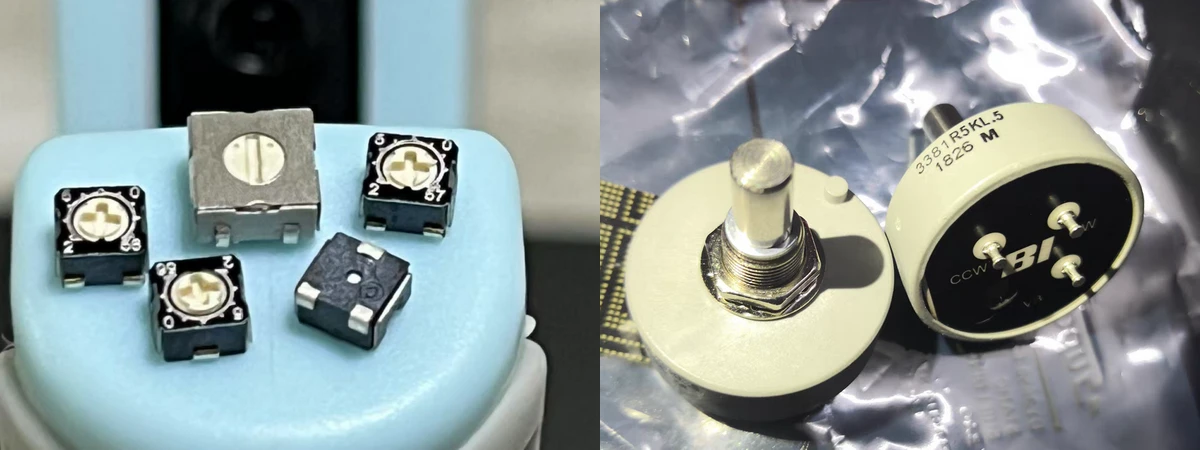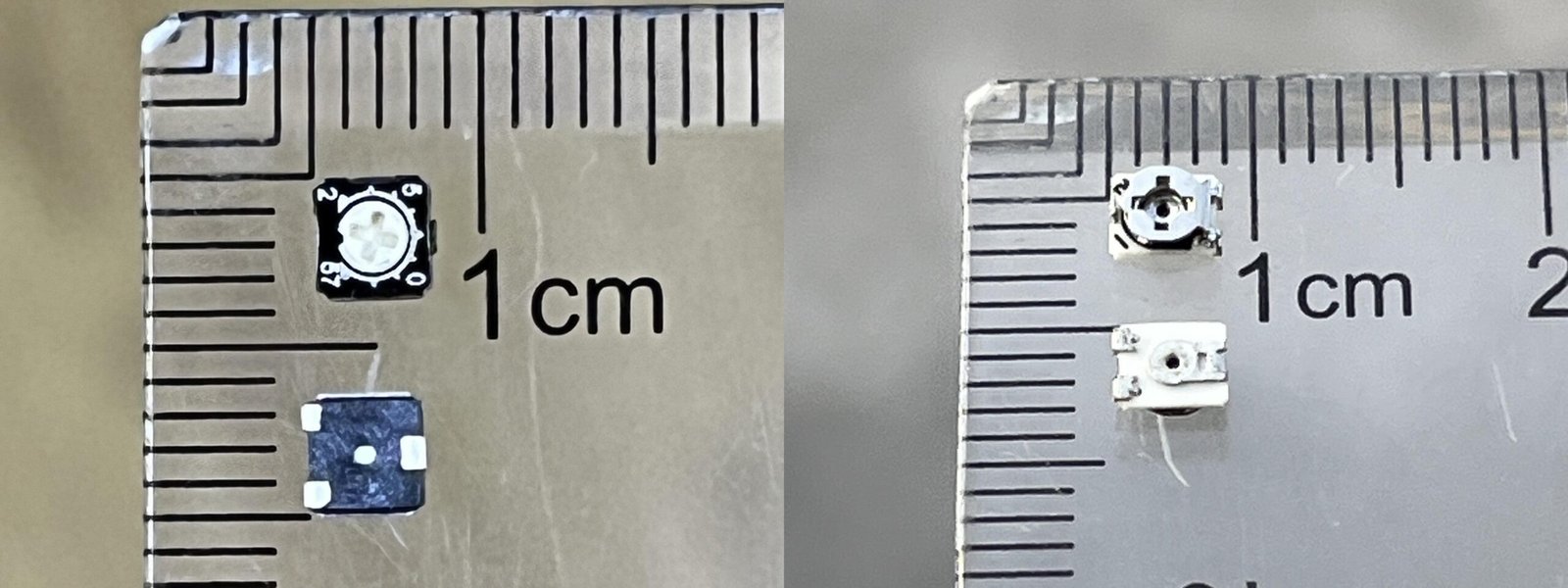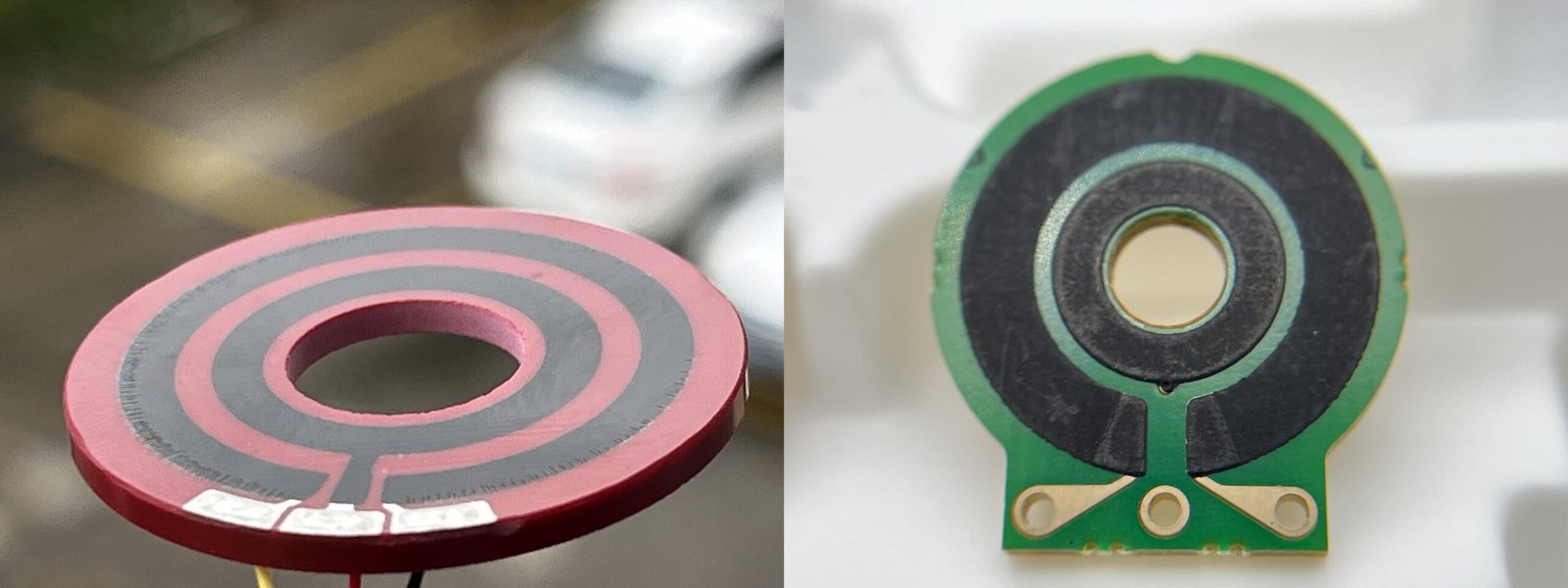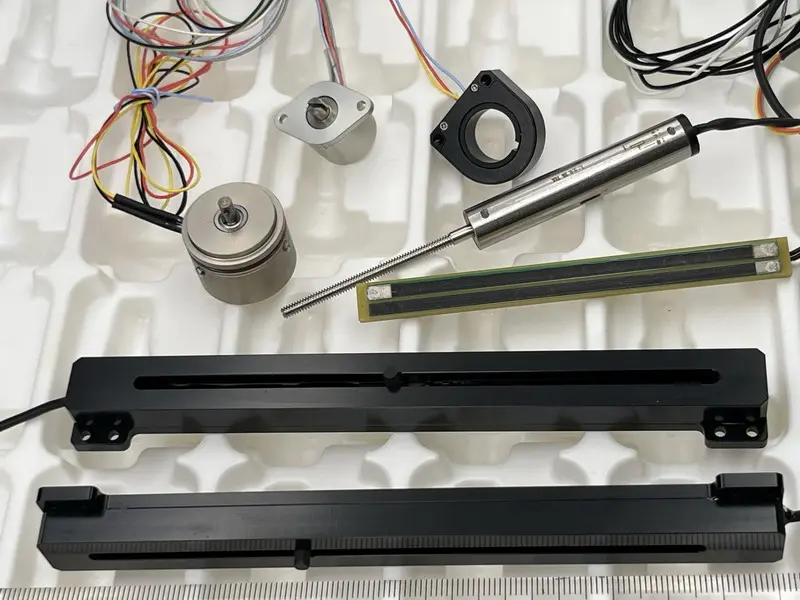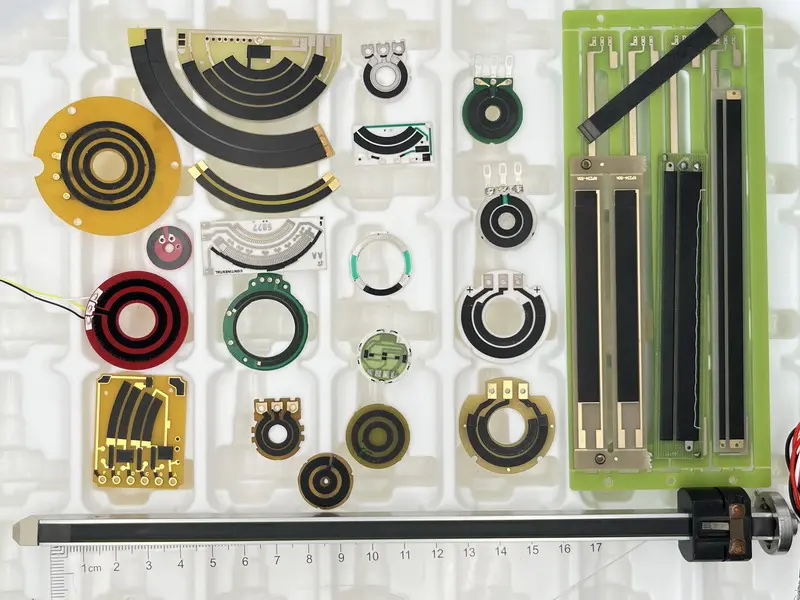1) Introduction
Potentiometers and sensors are fundamental components for precise position and signal detection in automation, robotics, transportation, aerospace, and countless other fields. Their performance and reliability hinge on the choice of resistive element—the core structure that determines sensitivity, accuracy, lifespan, and overall stability.
Different types of resistive elements—ranging from traditional thick film (carbon film) and advanced conductive plastic films, to metal film, wirewound, hybrid, and ceramic (cermet) structures—define not only the cost difference between products, but also their practical application range, environmental resistance, and long-term durability.
Why are some potentiometers and sensors priced just a few dollars, while others—often serving similar precision tasks—can reach hundreds of dollars each? The answer lies in the essential differences among these resistive elements: their materials, structure, manufacturing process, and performance under real-world conditions.
This article offers a comprehensive bilingual comparison, analyzing each major type of resistive element found in potentiometers and sensors. We examine their technical characteristics, manufacturing methods, performance strengths and weaknesses, and the reasons behind these differences. Real-world application examples and factory insights are provided to help engineers and buyers make truly informed choices.
| Type of Film Element | Typical Lifetime (cycles) | Linearity / Accuracy | Surface Wear | Temp Stability (TCR) | Application Examples | Cost Position |
|---|---|---|---|---|---|---|
| Thick Film (Carbon) | 5M+ | ±1–2% | Moderate | ±500 ppm/°C | Auto TPS, general automation | Low |
| Conductive Plastic | 10M–100M+ | ±0.1–0.5% | Minimal | ±200 ppm/°C | Robotics, aerospace, medical | High |
| Metal Film (Foil) | 5M–20M | ±0.2–1% | Low | ±100 ppm/°C | Audio/Pro, precision controls | High |
| Wirewound | 1M–20M+ | ±0.05–1% | Minimal | ±100 ppm/°C | Power, lab, industrial controls | Medium/High |
| Hybrid (Plastic + Wire) | 10M–50M | ±0.1–0.5% | Very low | ±200 ppm/°C | Aerospace, high-end automation | Highest |
| Ceramic Film | 1M–10M | ±1–2% | Moderate | ±300 ppm/°C | High-temp, industrial | Medium |
2) Thick Film (Carbon Film) Elements
| Attribute | Thick Film (Carbon Film) Resistive Element |
|---|---|
| Resistive Material | Carbon-based conductive ink in a thick film layer |
| Substrate | Typically phenolic resin or ceramic carrier |
| Manufacturing | Screen-printing of carbon paste onto substrate, cured or high-temp fired |
| Resistance Range | ~100 Ω to several MΩ |
| Temperature Range | ~−40°C to +125°C |
| TCR | Relatively high (~500–1000 ppm/°C) |
| Power Handling | Moderate |
| Resolution | Infinite (continuous film) |
| Lifespan | Moderate (~5M+ cycles) |
| Advantages | Low cost, wide resistance range, simple process, reliable for general use |
| Disadvantages | Not the highest precision/stability, more noise/drift in tough environments, faster wear in high-duty use |
| Typical Applications | Audio (volume/tone), home appliance controls, automotive dashboards, general controls |
Explanation:
Thick film (carbon film) resistive elements are manufactured by screen-printing a carbon-rich ink onto an insulating substrate, followed by curing or high-temperature firing. The carbon film is continuous, providing infinite adjustment resolution, and can be made in a wide range of resistance values. Its simple process and low cost make it ideal for mass-produced potentiometers and sensors where extreme precision or power handling is not required. However, carbon film is more sensitive to temperature/humidity changes, and wears faster with frequent adjustment or heavy-duty use.
3) Conductive Plastic Film Elements
| Attribute | Conductive Plastic Resistive Element |
|---|---|
| Resistive Material | Conductive polymer (carbon or graphite in plastic resin) |
| Substrate | Engineered plastic base or composite |
| Manufacturing | Injection molding or coating of polymer, then cured |
| Resistance Range | ~500 Ω to several MΩ |
| Temperature Range | ~−55°C to +125°C |
| TCR | Moderate-high (~500–1500 ppm/°C) |
| Power Handling | Lower (plastic heat limit) |
| Resolution | Infinite (very smooth adjustment) |
| Lifespan | Very long (often 1,000,000+ cycles) |
| Advantages | Silky feel, extremely long life, low noise, high resolution, good linearity |
| Disadvantages | Higher cost, less heat-resistant, some long-term drift possible |
| Typical Applications | Joysticks, servo feedback, throttle position sensors, high-end audio, precise/frequent adjustments |
Explanation:
Conductive plastic resistive elements are formed by molding or coating a polymer mixed with conductive particles onto an insulating base. The surface is extremely smooth, resulting in nearly silent, frictionless adjustment and very long lifespan. These elements tolerate high contact pressure and vibration, making them ideal for industrial sensors and potentiometers that require frequent, precise movement. Limitations include higher cost, somewhat limited heat tolerance, and rare long-term drift if not well sealed.
4) Metal Film Elements
| Attribute | Metal Film Resistive Element |
|---|---|
| Resistive Material | Thin metal alloy film (nickel-chrome, etc.) on ceramic/glass |
| Substrate | Ceramic or glass |
| Manufacturing | Vacuum deposition of metal film, laser trimmed |
| Resistance Range | ~10 Ω to 100 kΩ |
| Temperature Range | ~−55°C to +125°C |
| TCR | Very low (~50–200 ppm/°C) |
| Power Handling | Low-moderate |
| Resolution | Infinite |
| Lifespan | Limited for frequent adjustments (best for trim/rare use) |
| Advantages | High precision, low noise, very stable over temperature, no step effect |
| Disadvantages | Wear out quickly if used often, higher cost, resistance range limited |
| Typical Applications | Precision trimmers, calibration, laboratory instruments, stable infrequent adjustments |
Explanation:
Metal film resistive elements use a vacuum-deposited alloy layer, typically on ceramic. They provide high accuracy, tight tolerances, and excellent temperature stability, making them ideal for calibration and scientific instruments. However, their mechanical wear resistance is limited; frequent use can wear out the film, so they're mainly for presets and fine adjustments, not daily controls.
5) Wirewound Elements
| Attribute | Wirewound Resistive Element |
|---|---|
| Resistive Material | Resistance wire (nickel-chrome, constantan, etc.) |
| Core/Substrate | Insulating bobbin (ceramic/plastic) |
| Manufacturing | Precision winding of wire on core |
| Resistance Range | ~1 Ω to 100 kΩ |
| Temperature Range | ~−55°C to +150°C |
| TCR | Very low (<50 ppm/°C) |
| Power Handling | High |
| Resolution | Discrete steps between wire turns (“zipper noise”) |
| Lifespan | Moderate (20k to >1M cycles, design-dependent) |
| Advantages | Robust, high power/precision, stable over time and temperature |
| Disadvantages | Stepped output, inductance, larger size, wear at contact points |
| Typical Applications | Rheostats, power control, multi-turn calibration, harsh environments |
Explanation:
Wirewound resistive elements use a precision-wound resistance wire on an insulating core. They handle high power and maintain stability even in tough conditions. However, the output is not truly continuous—it has small steps as the wiper moves from turn to turn, and long-term mechanical wear is possible.
6) Hybrid Elements
| Attribute | Hybrid Resistive Element (Wirewound + Conductive Plastic) |
|---|---|
| Resistive Material | Wirewound core overlaid with conductive plastic film |
| Structure | Wire coil coated with conductive plastic |
| Manufacturing | Winding + plastic coating, cured |
| Resistance Range | ~1 Ω to 50 kΩ |
| Temperature Range | ~−40°C to +125°C |
| TCR | Low (like wirewound) |
| Power Handling | High |
| Resolution | Infinite (plastic film smooths out wire steps) |
| Lifespan | Very long (plastic layer absorbs wear) |
| Advantages | High power and stability + smooth, noise-free adjustment, long life |
| Disadvantages | More expensive, complex, limited options, larger size |
| Typical Applications | High-end servo feedback, military/aerospace, robust industrial sensors |
Explanation:
Hybrid resistive elements combine a wirewound core with a conductive plastic overlay, achieving both the power handling of wire and the smooth, noise-free operation of plastic film. They’re ideal for applications demanding both ruggedness and high-resolution, low-noise output, such as advanced servo feedback.
7) Ceramic (Cermet) Elements
| Attribute | Ceramic (Cermet) Resistive Element |
|---|---|
| Resistive Material | Cermet thick-film (e.g. ruthenium oxide + glass on ceramic) |
| Substrate | Alumina ceramic |
| Manufacturing | Thick-film screen printing, high-temp firing, laser trim |
| Resistance Range | ~50 Ω to 2 MΩ |
| Temperature Range | ~−55°C to +150°C |
| TCR | Low (typically 50–200 ppm/°C) |
| Power Handling | Moderate-high |
| Resolution | Infinite (hard film) |
| Lifespan | Moderate-high (long life but surface is abrasive) |
| Advantages | Excellent stability, low drift, low noise, robust in harsh environments |
| Disadvantages | Costly, not as smooth as plastic, wiper wear if unlubricated |
| Typical Applications | Precision instruments, aerospace/military, robust automotive sensors, test/audio equipment |
Explanation:
Cermet resistive elements are made by thick-film printing and firing metal-ceramic ink on alumina. They feature high environmental stability, low drift, and low noise, making them perfect for precision instruments and harsh environment sensors. Surface hardness can cause wiper wear if not lubricated, and cost is higher than plastic or carbon types.
8) Conclusion:
Each type of resistive element for potentiometers and sensors offers a unique combination of cost, durability, stability, and performance. By understanding their strengths and limitations, engineers and buyers can select the most suitable technology for each application—whether that’s everyday adjustment, extreme reliability, high power, or ultra-precise calibration.
NOLELC’s Flexible Production & Expertise:
NOLELC specializes in the design and production of thick film and conductive plastic resistive elements for potentiometers and sensors, supporting both standard and custom solutions. Our advanced manufacturing processes and experienced team ensure consistent quality, fast delivery, and close cooperation with clients’ technical requirements. If your project demands reliable, high-performance resistive elements, NOLELC is your trusted partner.



